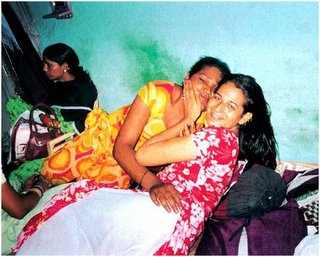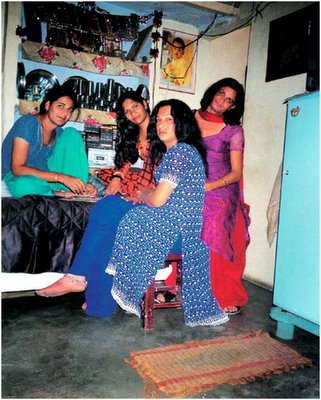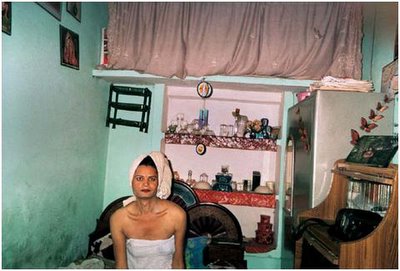
An exhibition of photographs by the transgender community of Delhi ran from May 5th to 23rd 2005 at Max Mueller Bhawan's Siddartha Hall in New Delhi.
This collection images you are about to see will hopefully motivate you to shed your fears, anxieties and insecurities about hijras, or transgender people.
"As a photographer, I always find it challenging to work with marginalised communities. One of the reasons they are marginalised is due to the way they get represented in society. Whether it is the transgender community, sex workers, the diasporic community, tribal groups or religious minorities, they all face similar problems. Living on the periphery of mainstream society not only a physical reality but also invades their psyche. And due to little or no information about them they are regarded “Exotica”. Things that are unknown often romanticised. This then is an issue of identity, pushed outside of the normative - the parameters of which are determined by the mainstream society.
Transgender communities are a part of our society and have created a world of their own. They have their own kinds of relationships, unusual means of livelihood and importantly an identity which constantly underlines their exclusion.
 For many years now the community has been subjugated to roving eye of anthropologists, photographers and their ilk who made them subject of their study and represented them most of the time in a context which is not theirs. A single photograph projects an image of a person/ situation mostly out of context. Even a small article with few images cannot in most instances do justice to this community.
For many years now the community has been subjugated to roving eye of anthropologists, photographers and their ilk who made them subject of their study and represented them most of the time in a context which is not theirs. A single photograph projects an image of a person/ situation mostly out of context. Even a small article with few images cannot in most instances do justice to this community.Hijras or the transgender community enjoys the mystery which surrounds them. This helps them in their business of cruising in zones created by them for themselves. They not only like to appear different in the body sense but also their mannerisms are idiosyncratic. They use this performance/act to iterate the identity that mainstream society has cast them in. To represent the true character of such a group for an outsider is a humongous task. They might allow you to help them in their territory on their terms and conditions for a purpose which they have no control over. In other words they might seek an outsider’s help for lets say health care, education or even legal advice but they never are sure about how they would like the world at large to look at them.
In the 1990’s I conducted a workshop with children in Mangolpuri, a resettlement colony in outskirts of Delhi. In that workshop I had given aim and shoot cameras to participants who were in the age group 9 to 15. The par
 ticipants - all children, had not taken a photograph or even held a camera in their lives. It was my first attempt to understand how children look at things through a camera, how they frame their subject and how they perceive things. The results were astounding. We first printed and exhibited their prints in a Baarat ghar (Community Centre) where they proudly invited their parents for the inauguration. The exhibition traveled to one of the most prestigious galleries in India at the Centre for photography as an art form at NCPA, Mumbai. I am not sure how much my participants from the workshop learnt about photography but they sure had lot of fun exploring the world of looking and telling! For me - I discovered a new vision - a vision that was beyond my own.
ticipants - all children, had not taken a photograph or even held a camera in their lives. It was my first attempt to understand how children look at things through a camera, how they frame their subject and how they perceive things. The results were astounding. We first printed and exhibited their prints in a Baarat ghar (Community Centre) where they proudly invited their parents for the inauguration. The exhibition traveled to one of the most prestigious galleries in India at the Centre for photography as an art form at NCPA, Mumbai. I am not sure how much my participants from the workshop learnt about photography but they sure had lot of fun exploring the world of looking and telling! For me - I discovered a new vision - a vision that was beyond my own.When I started on this project I had imagined that the Mangolpuri experience would give me some directions in working with the transgender community. But that was clearly not the case. As I started out I discovered that there have been many attempts to showcase transgender community through photographs, documentaries, books and exhibitions by outsiders. It took several discussions to explore the idea that they are perhaps in a better position to communicate to the world outside of theirs the many facets of their existence. Unfolding the layers of misinformation, exposing and showcasing their lives would perhaps be the best way to bridge the disconnect. In the process they got involved thoroughly and had one goal in mind that they should be seen as human beings and no less or more.
 For the first meeting when I entered the SAHARA clinic at Yamuna Pushta, the largest slum of Delhi, with Anjalee and Shantanu from SAHARA we heard lot of music and laughter. Not knowing what to expect, I found we were greeted by a room full of hijras. They were as anxious as we were. As I greeted them I realized in this project there are going to be no directors, no experts, no subjects and no underdogs. To break the ice I had taken few books which I shared with them. As they started looking at images they got interested in the costumes and makeup of people in those images, the situation in which it was taken and started laughing and sometimes even quarreling. After some discussion they told me that they would like to do this project. They were very willing to participate but will have to take permissions from their respective Gurus.
For the first meeting when I entered the SAHARA clinic at Yamuna Pushta, the largest slum of Delhi, with Anjalee and Shantanu from SAHARA we heard lot of music and laughter. Not knowing what to expect, I found we were greeted by a room full of hijras. They were as anxious as we were. As I greeted them I realized in this project there are going to be no directors, no experts, no subjects and no underdogs. To break the ice I had taken few books which I shared with them. As they started looking at images they got interested in the costumes and makeup of people in those images, the situation in which it was taken and started laughing and sometimes even quarreling. After some discussion they told me that they would like to do this project. They were very willing to participate but will have to take permissions from their respective Gurus. I took this to be a good sign as they were all willing and excited about this newfound activity. This was not just to be an experience of clicking photographs and looking at themselves only, but also about meeting new people like us. In next meeting we discussed further about how to proceed. We discussed some themes which would allow them to look at things around them. The group of participants was never the same. They would come and go. I realized that this is going to be pattern and I will have to accept the situation. The good rapport that Sahara had with the community facilitated the discussions on many instances. The Hijra community lives all across Delhi and they have their areas marked for their business/work. It became easy for us to distribute cameras according the area they stayed. We made pairs of two and they took their first film rolls with great excitement. Two weeks later I received about 10 film rolls, each one labeled with names. When I saw prints I was amazed with the results, also because I did not know what to expect! I took these prints for our next rendezvous and I shared them with both the groups the one who shot these images and the next group who would be shooting. They were really excited and wanted to shoot more.
I took this to be a good sign as they were all willing and excited about this newfound activity. This was not just to be an experience of clicking photographs and looking at themselves only, but also about meeting new people like us. In next meeting we discussed further about how to proceed. We discussed some themes which would allow them to look at things around them. The group of participants was never the same. They would come and go. I realized that this is going to be pattern and I will have to accept the situation. The good rapport that Sahara had with the community facilitated the discussions on many instances. The Hijra community lives all across Delhi and they have their areas marked for their business/work. It became easy for us to distribute cameras according the area they stayed. We made pairs of two and they took their first film rolls with great excitement. Two weeks later I received about 10 film rolls, each one labeled with names. When I saw prints I was amazed with the results, also because I did not know what to expect! I took these prints for our next rendezvous and I shared them with both the groups the one who shot these images and the next group who would be shooting. They were really excited and wanted to shoot more.  They talked about each of these images they had selected and why. This was then recorded and translated for the catalogue and exhibition. They were asked to select two to three photographs, which they would like to exhibit. They also created the narration for each of the photographs that they selected.
They talked about each of these images they had selected and why. This was then recorded and translated for the catalogue and exhibition. They were asked to select two to three photographs, which they would like to exhibit. They also created the narration for each of the photographs that they selected.When I see these images which are photographed, modeled and selected by Hijra’s themselves I feel reassured that our decision to make them part of this entire process was completely valid. These images work at many levels. For one in it allows you to journey into their lives from their point of view. It is clear from the pictures that they want to share, want others to know how they live - that this is how they eat, bathe, dance, feel sad, and survive. I kept my role as minimal as possible as I wanted very little outside influence in this venture. This visual journey defines their very identity. The transgender community in this project has unveiled their lives into the public space. This is one of those rare instances where they have modeled, photographed and written about themselves for a book and exhibition which is meant for a world outside their own. I personally believe that this effort will contribute to doing away with stigmas. An increased understanding of their lives, will foster the realization that they are people first and transgender afterward."
I personally believe that this effort will contribute to doing away with stigmas. An increased understanding of their lives, will foster the realization that they are people first and transgender afterward."
 I personally believe that this effort will contribute to doing away with stigmas. An increased understanding of their lives, will foster the realization that they are people first and transgender afterward."
I personally believe that this effort will contribute to doing away with stigmas. An increased understanding of their lives, will foster the realization that they are people first and transgender afterward."Imaging Self,
by Parthiv Shah
Director
Centre for Media and Altrernative Communciation (CMAC)
Delhi, India
Only a few of his works are featured here.
Thank you for introducing us to Kaaya. I wish I could have seen the exhibit. My students are currently reading The Third Gender by Su. Samuthiram, and I look forward to showing them this page.
ReplyDeleteBest wishes from Wyoming, USA